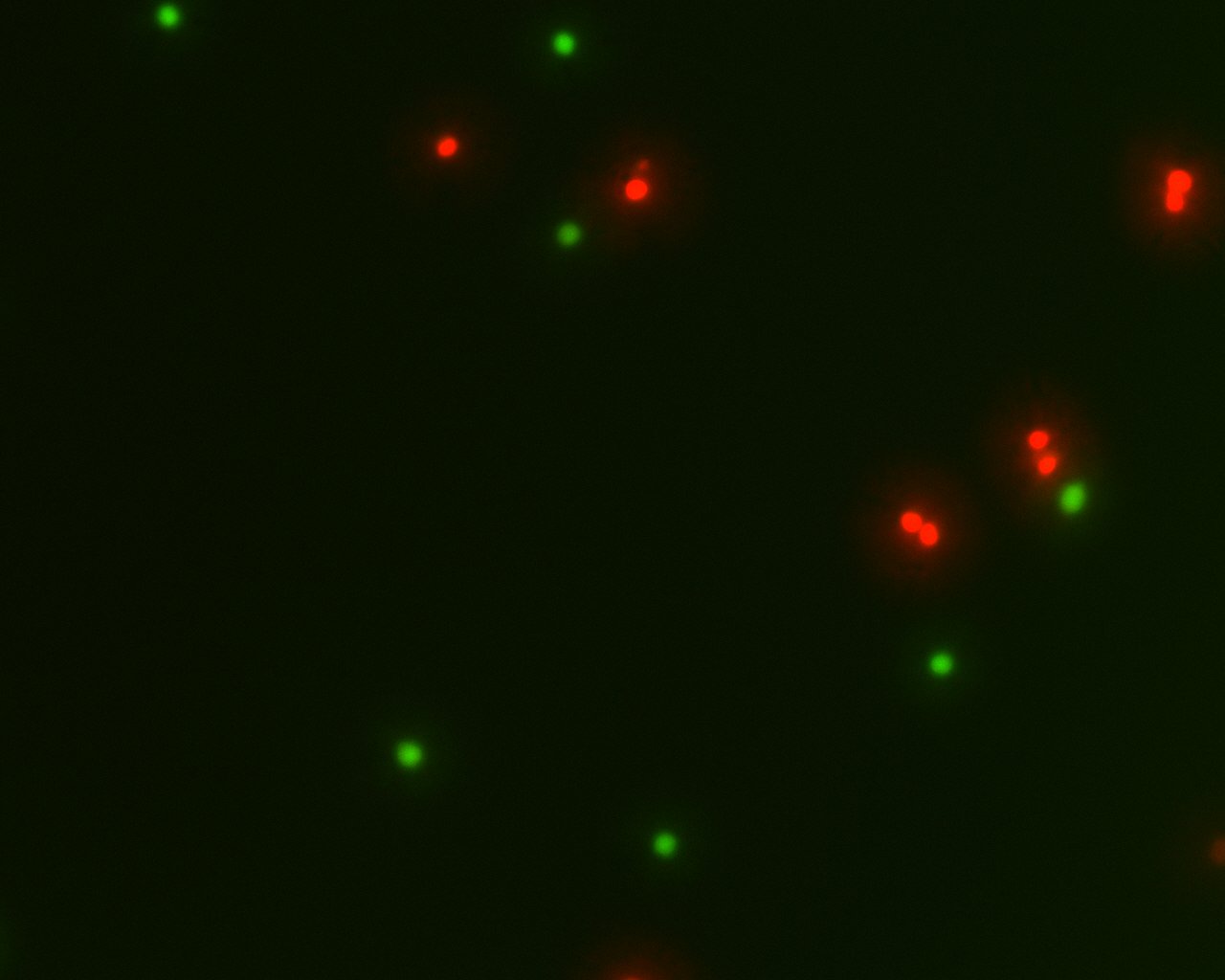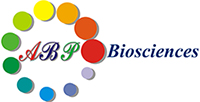The Cell-Check™ Viability/Cytotoxicity Kit for Animal Cells provides a two-color fluorescence staining on both live and dead cells using two probes that measure two recognized parameters of cell viability — intracellular esterase activity and plasma membrane integrity. The kit is suitable for use with fluorescence microscopes, fluorescence multiwell plate scanners and flow cytometers and other fluorescence detection systems. The assay principles are general and applicable to most eukaryotic cell types, including adherent cells and certain tissues, but not to bacteria or yeast. It is generally faster, less expensive, safer and a more sensitive indicator of cytotoxic events than alternative methods.
Live cells are distinguished by the presence of ubiquitous intracellular esterase activity, determined by the enzymatic conversion of the virtually nonfluorescent cell-permeant calcein AM to the intensely fluorescent calcein. The polyanionic dye calcein is well retained within live cells, producing an intense uniform green fluorescence in live cells (Ex/Em ~495 nm/~520 nm). Propidium iodide (PI) enters cells with damaged membranes and undergoes a 30-fold enhancement of fluorescence upon binding to nucleic acids, thereby producing a bright red fluorescence in dead cells (Ex/Em ~528 nm/~617 nm). PI is excluded by the intact plasma membrane of live cells.
Features:
- Simplicity: Reagents are simultaneously added, no wash steps are required
- Specificity and reliability: Distinct color for live and dead cell
- Versatility: Suitable for fluorescence microscope, flow cytometer or microplate reader
|
Specifications |
||
| Platform: | Fluorescence Microscopy, Flow Cytometry |
|
| Detection Method: | Fluorescent | |
| Ex/Em: | Calcein: 494/517; PI: 535/617 nm | |
| Product Size: | 1000 assays | |
| Storage Conditions: | -20 ℃, protect from light | |
| Shipping Condition: | Ice pack | |
|
Applications
Cell viability assay |
||

Figure 1. Live and dead Jurkat cells stained with Cell-Check™ Viability/Cytotoxicity Kit (A017). Live cells fluoresce a bright green, whereas dead cells fluoresce red.
| Protocol (PDF): | A017 | |
| MSDS (PDF): | Component A | Component B |
| COA (PDF): | COA-A017 |
Frequently asked questions (FAQs)
I am doing a Cell-Check™ assay using Calcein, AM, for live cells and PI for dead cells. Can I fix the cells after labeling and retain the staining?
This is not recommended. Neither Calcein nor PI bind to any cellular components upon fixation. There is no guarantee that the dyes will be retained upon fixation or any subsequent wash steps. We recommend scoring for live and dead cells as soon as possible after staining.
I need to use a dead cell control for my viability assay. Do you have a protocol for killing cells for this?
Heat killing is commonly used. Place your cells in a tube in buffer and heat at 60oC for 20 minutes. You can also kill your cells by fixing them with ice cold 70% ethanol for 15 minutes. The ethanol-killed cells can then be stored at -20oC until needed, at which point you wash out the ethanol and replace with buffer.
Cited Reference:
Antibacterial effect of bacteriocin XJS01 and its application as antibiofilm agents to treat multidrug-resistant Staphylococcus aureus infection
Yi-Zhou Xiang, Gang Wu, Lin-Yu Yang, Xiao-Jie Yang, Yan-Mei Zhang, Lian-Bing Lin, Xian-Yu Deng, Qi-Lin Zhang
International Journal of Biological Macromolecules, 2022, 196, 13-22, https://doi.org/10.1016/j.ijbiomac.2021.11.136
A novel bacteriocin against Staphylococcus aureus from Lactobacillus paracasei isolated from Yunnan traditional fermented yogurt: Purification, antibacterial characterization, and antibiofilm activity
Yu-Hang Jiang, Wei-Gang Xin, Lin-Yu Yang, Jian-Ping Ying, Zi-Shun Zhao, Lian-Bing Lin, Xiu-Zhang Li, Qi-Lin Zhang
Journal of Dairy Science, 2022, 105(3):2094-2107. https://doi.org/10.3168/jds.2021-21126
Antibacterial activity and action target of phenyllactic acid against Staphylococcus aureus and its application in skim milk and cheese
Yu-Hang Jiang, Jian-Ping Ying, Wei-Gang Xin, Lin-Yu Yang, Xiu-Zhang Li, Qi-Lin Zhang
J. Dairy Sci. 2022, 105:9463–9475. https://doi.org/10.3168/jds.2022-22262
Purification, characterization, and antibacterial and antibiofilm activity of a novel bacteriocin against Salmonella Enteritidis.
Xiang, Y.-Z., Zhang, Y.-M., Liu, Y.-Y., Zhang, M., Lin, L.-B., & Zhang, Q.-L.
Food Control, 2021, 127, 108110. doi:10.1016/j.foodcont.2021.10
A Novel Bacteriocin Against Shigella flexneri From Lactiplantibacillus plantarum Isolated From Tilapia Intestine: Purification, Antibacterial Properties and Antibiofilm Activity.
Jiang Y-H, Xin W-G, Zhang Q-L, Lin L-B and Deng X-Y
Front. Microbiol. 2022, 12:779315. doi: 10.3389/fmicb.2021.779315
Effect of surface sealant on surface roughness and bacterial adhesion of bulk-fill composites
Gunce Ozan, Meltem Mert Eren, Cansu Vatansever and Ugur Erdemir
Polymers and Polymer Composites, 2021, Vol. 29(9S) S475–S484. DOI: 10.1177/09673911211005586
Antibacterial activity and mechanism of action of bacteriocin LFX01 against Staphylococcus aureus and Escherichia coli and its application on pork model
Wei-Gang Xin, Gang Wu, Jian-Ping Ying, Yi-Zhou Xiang, Yu-Hang Jiang, Xian-Yu Deng, Lian-Bing Lin, Qi-Lin Zhang
Meat Science, 2023, 196, 109045, https://doi.org/10.1016/j.meatsci.2022.109045
Streptococcus Mutans adhesion to dental restorative materials after polishing with varioussystems:AConfocal Microscopy study
M.MertErena,G.Ozanb,U.Erdemirb,C.Vatansever
Acta Microscópica, 2021, 30, 1, 53-64
A novel bacteriocin from Lactobacillus salivarius against Staphylococcus aureus: Isolation, purification, identification, antibacterial and antibiofilm activity
Hong-Wei Li, Yi-Zhou Xiang, Man Zhang, Yu-Hang Jiang, Yao Zhang, Ying-Yang Liu, Lian-Bing Lin, Qi-Lin Zhang
LWT, 2021, 140, 110826, https://doi.org/10.1016/j.lwt.2020.110826

